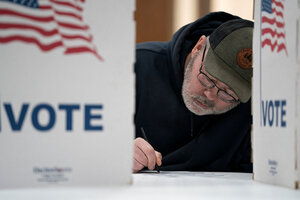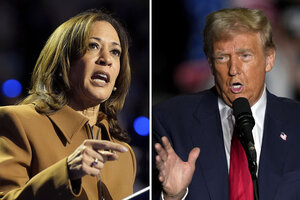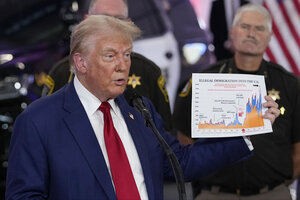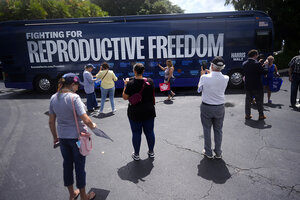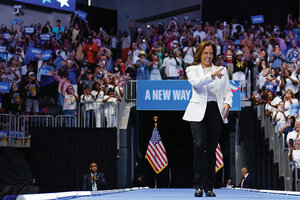What’s engaging these high schoolers? Classes about the election.
Lawson Waldrop used to have a spotty attendance record. So far this academic year, the 12th grader in Bar Harbor, Maine, says she has barely missed a day of school.
What’s the gravitational pull bringing her to class? A nine-week elective course all about the upcoming election.
“It feels like the most important class to me,” says Lawson, who turned 18 over the weekend. “English is cool and all, but this is, like, real-world stuff that I need to know, especially because I’m going to be partaking in the election.”
Every four years, the presidential election energizes civics education. It presents a natural opportunity for educators to discuss topics such as the Electoral College, campaign finance, and the policy issues being debated – even if they say it has gotten trickier in recent years. Nearly a third of principals surveyed in August by EdWeek Research Center say a “challenging” or “very challenging” obstacle to civics education has been the notion that it’s too political or controversial.
Still, experts say learning about elections and the democratic process can lead to greater civic engagement among young people. A fringe benefit, though, may be student engagement. In an age of chronic absenteeism, some educators are finding that leaning into election topics piques students’ interests and keeps them motivated to learn.
When students have a chance to talk about their identity and values, it breeds engagement both inside and outside the classroom, says Adrianne Billingham Bock, director of curriculum and implementation for the Harvard University-based Democratic Knowledge Project. The group partners with educators to co-design civics lessons.
“Students see and are able to really bring who they are and what matters to them into the classroom,” she says. “We know that supports authentic civic engagement as well.”
It’s also a chance for students to learn about the nuts and bolts of the election process itself.
In 2022, less than a quarter (22%) of eighth graders demonstrated civics proficiency on the National Assessment of Educational Progress, known as “the nation’s report card.” The relatively low percentage underscores what educators and civics advocates say is a concerning trend for democracy in the United States as a whole.
In Bar Harbor, Maine, the Election Year class debuted this fall at Mount Desert Island High School. It joined the school’s roster of other niche electives such as courses on the Holocaust, Civil War, Vietnam War, forensics, astronomy, and outdoor science.
“It’s not that they’re not rigorous, but it’s not your typical world history or chemistry or something that everybody takes,” Principal Matt Haney says. “If you signed up for this class, it’s because you’re interested in it. It gets to be a great learning environment when everybody wants to be there.”
In Wyoming, encouraging informed voters
More than 2,000 miles to the west, Principal Katie Law is deploying a similar strategy at Arapaho Charter High School in Arapahoe, Wyoming. The school serves about 55 students, most of whom belong to the Eastern Shoshone and Northern Arapaho tribes. Since taking on the leadership role nearly seven years ago, Ms. Law has been on a mission to boost student attendance and, ultimately, the school’s graduation rate.
The former social studies teacher has found that emphasizing the upcoming election – and preparing eligible students to vote – has helped. She encourages her students to be informed voters.
“You’re not going to be informed if you’re not coming to school,” Ms. Law says.
Last month, her students watched and analyzed the debate between former President Donald Trump and Vice President Kamala Harris. Beforehand, they jotted down the issues they hoped to hear discussed and, afterward, reflected on what the candidates actually debated.
Information about local candidates, tribal elections, ballot initiatives, and the U.S. party system plays a role in the educational run-up to the election, too. Ms. Law also asks students to think about their own values and causes. She says many point to issues such as mental health or missing and murdered Indigenous people. In mid-October, eligible students – based on age and tribal enrollment – participated in a tribal primary election.
The grand finale, of course, comes on Election Day itself. Ms. Law says students who are 18 years or older plan to cast their ballots at the school campus, which is a polling location, and then visit a bigger voting center to see the “buzz” on Nov. 5. For a previous election, students dressed in tribal-inspired clothing, voted at a county courthouse, posed for photos afterward, and then stopped at Starbucks for a postvote treat.
It’s the culmination of an effort that Ms. Law hopes will pay dividends for her students throughout their lives.
“If you want your voice heard or you want change, step one is voting,” she says.
While the election may be a hook for student engagement, the classroom can also provide a safe forum for children and teens to discuss their views and learn from their peers’ perspectives as well. The polarized national discourse certainly may cause some hesitation among teachers to dive into those discussions, says Ms. Billingham Bock of the Democratic Knowledge Project.
“I also think that civics teachers really know that part of their responsibility [is] to teach about elections and to set agreements on how we talk to one another in our community,” she says.
Modeling civil discourse
Elana Diaz, who teaches the Election Year course in Maine, says she and her teaching assistant, Megan Leddy, strive to model civil discourse. They bounce ideas back and forth during classroom discussions. And the duo hasn’t shied away from thorny topics like how the Israel-Hamas war or immigration policy may affect upcoming elections at the national, state, and local levels.
As for engagement, Ms. Diaz credits the student-driven nature of the class with helping. She crafts lesson plans around what students already know, want to know, or where their interests lie.
“There’s an urgency that’s lacking sometimes and a disconnect between learning about the past and applying it to the future,” she says. “And so this class is just an amazing opportunity to talk about important issues.”
Even if the candidates themselves sometimes avoid doing so. Isa Raven, a 12th grader who is taking the course, says analyzing the recent Trump-Harris debate ended in disappointment.
“I felt like both Trump and Harris would make a point about their policy, but then they just go off and they’d start insulting each other,” she says.
The 17-year-old can’t vote in this year’s election. Even so, she still wanted to hear more about the candidates’ plans if elected.
Isa says she appreciates that the course encourages thoughtfulness and discussion as opposed to certain core subjects, where students are just chasing a high grade.
“This is nice,” she says, “because we can be like, ‘OK, the debate was last night. Let’s just chat about it.’”









